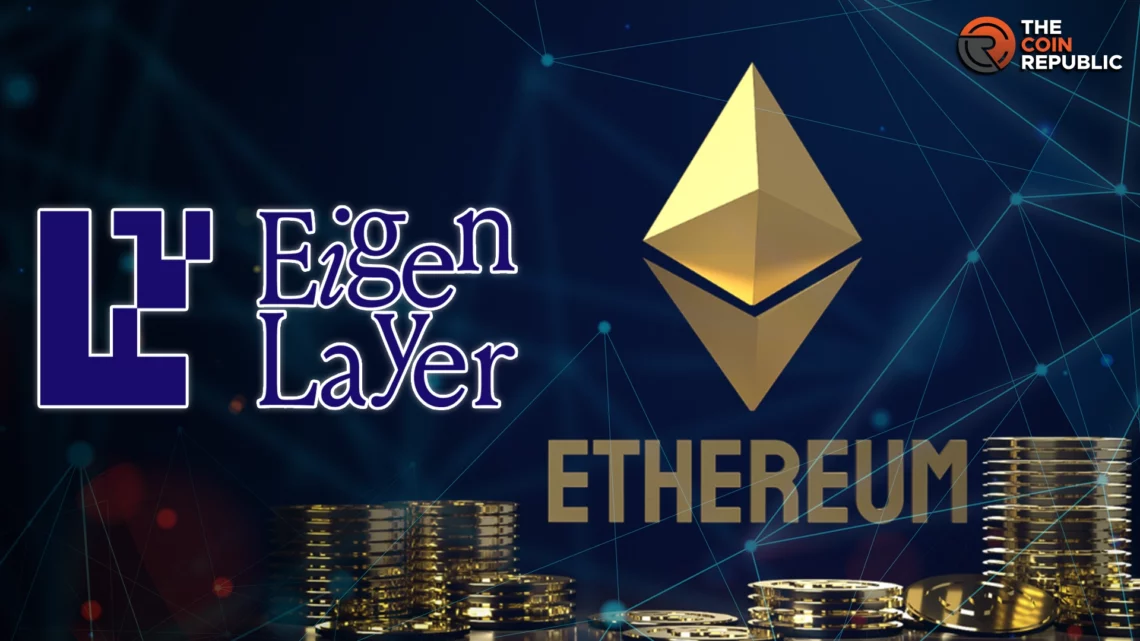Restaking is simple: you stake your assets in multiple projects simultaneously, potentially doubling your earnings. While not a new idea, it emerged alongside the expansion of decentralized exchanges in 2018.
This article delves into staking and restaking processes, their benefits for the cryptocurrency ecosystem, and forecasts their future evolution.
What Is EigenLayer?
EigenLayer is an Ethereum-based system that introduces restaking, a new standard in crypto-economic security. It essentially allows for the reuse of ETH on the consensus layer.
Users that stake ETH natively or with a liquid staking token (LST) can use EigenLayer smart contracts to restake their ETH or LST and expand crypto-economic security to other applications on the network, earning further benefits.
How Does EigenLayer Work?
EigenLayer introduces a novel approach to cryptoeconomic security, addressing challenges in Web3 networks like Ethereum. Traditional blockchain designs often result in fragmented security, especially on Ethereum, where each application creates its trust network.
This process is resource-intensive and time-consuming. EigenLayer tackles this issue by introducing a new concept called the restaking primitive. Restaking is implemented through a set of smart contracts where users stake $ETH to extend security to other applications on the network.
EigenLayer allows users to reutilize their locked $ETH for broader security purposes. It creates a middle layer where users grant EigenLayer additional enforcement rights on their staked $ETH, enabling it to be restaked onto other applications.
An essential feature of EigenLayer is its opt-in mechanism, where users agree to provide additional slashing conditions on their staked $ETH. These conditions persist above the consensus layer, allowing EigenLayer to enforce honest behavior and deter malicious activities.
EigenLayer’s design enables staked $ETH to serve validation purposes beyond Ethereum, supporting other projects such as bridges and data availability layers. This approach enhances security while promoting extensibility across the Ethereum network.
EigenLayer Architecture Overview
Restaking allows stakers to increase security for services within the EigenLayer ecosystem called Actively Validated Services (AVSs). For this purpose, stakers can restake their Native ETH or Liquid Staking Tokens (LST).
Operators run AVS software and play a crucial role in the EigenLayer ecosystem. They register in EigenLayer and allow stakers to delegate to them. Operators then opt-in to provide various services (AVSs) on EigenLayer.
Delegation is where stakers delegate their staked ETH to operators or become operators to run validation services. This process involves a double opt-in between both parties, ensuring mutual agreement. Restakers maintain control over their stake and choose which AVSs they opt-in to validate for.
AVSs are services built on the EigenLayer protocol that utilizes Ethereum’s shared security. Operators validate these services, contributing to the network’s security and integrity. AVSs deliver services to users (AVS Consumers) and the broader Web3 ecosystem, enhancing EigenLayer’s functionality and utility.
What Is staking?
Staking is a popular feature in the crypto world, offering traders a dependable source of passive income.
Users lock their cryptocurrency to stake in a staking pool, exchange, or smart contract. They earn interest on their staked assets while the network uses them to enhance security. The more funds staked, the higher the passive income.
Major stakeholders often become validators involved in transaction validation and voting on network improvements. Stakers are incentivized to protect the blockchain, reducing the likelihood of malicious behavior. Validators on Ethereum face penalties if they act against the network’s interests.
Decentralized staking is seen as a more accessible validation form than PoW. In PoW, miners compete to validate blocks, with high equipment costs and increasing difficulty for newcomers.
Staking on Ethereum is akin to having a savings account, requiring minimal user effort. Staking pools have made it accessible even to users with limited funds.

What is restaking, and how does EigenLayer support it?
Restaking, unique to EigenLayer, enhances traditional staking by offering users new avenues for passive income generation and network security reinforcement.
EigenLayer’s restaking process involves repurposing staked Ethereum to bolster security on other protocols. Users can opt-in to EigenLayer’s restaking smart contract through their staked Ether (ETH) or liquid staking tokens (LST).
Liquid staking tokens represent staked assets and allow users to restake them without unstaking the original assets.
Restaking through EigenLayer can be done using either already-staked ETH (native restaking) or LST restaking. In native restaking, users contribute their staked ETH to the protocol’s security pool. The security of EigenLayer depends on the size of this security pool.
Applications on EigenLayer, known as actively validated services (AVSs), include bridges, DApps, and oracles. Building on EigenLayer is cost-effective and efficient due to its established trust network, formed by restakers. AVSs are managed by node operators, volunteers, or organizations responsible for network management.
Node operators can build their AVSs or provide services to existing ones, earning rewards in return. However, operators must adhere to an AVS’s slashing requirements or face penalties for failing to perform their duties.
Operators can also be restakers, or restakers can delegate their restaked assets to operators. Restakers retain control over which services their assets support, creating a decentralized governance system. Developers utilize EigenLayer’s security, while operators and restakers earn rewards for maintaining it.
The advantages and disadvantages of EigenLayer.
EigenLayer introduces innovative solutions to Ethereum’s proof-of-stake mechanism but also brings its challenges.
Pros:
- Additional passive revenue: Restakers can earn higher rewards using their staked assets instead of traditional staking methods.
- Improving developer success rates: EigenLayer’s security pool removes a significant barrier for new projects, allowing developers to focus on providing valuable services without the burden of establishing trust.
- Potential for innovative layer-2 projects: By eliminating barriers to entry, EigenLayer may help genuinely innovative layer-2 projects thrive.
Cons:
- Higher barrier to entry: Restaking may overwhelm some users, as it requires additional technical knowledge and effort compared to traditional staking methods offered by crypto exchanges.
- Increased risk: EigenLayer’s AVSs have different slashing rules than traditional staking, exposing restakers to higher risks if they fail to fulfill their duties. Restakers also double their exposure to security risks, as they must trust Ethereum’s smart contract code and EigenLayer’s development prowess.
- Trust in EigenLayer’s development: Restakers must trust EigenLayer’s development process and the quality of its AVSs, which may deter risk-averse users. However, since both Ethereum and EigenLayer’s code are open-source, knowledgeable developers can assess the code before staking their assets.
Conclusion
EigenLayer stands out as one of the most intriguing protocols developed recently. Its architecture offers benefits to various stakeholders, including developers and market participants.
Developers can now access boundless innovation possibilities, while market participants can leverage their capital to earn higher rewards.
This advancement is poised to enhance the blockchain landscape, bolstering security and fostering innovation in the market. Consequently, it is expected to attract more users to participate in the ecosystem, driving its growth.
With the testnet now live, we’ve compiled a guide on interacting with the EigenLayer testnet.
This guide provides a better understanding of how the protocol operates and offers the opportunity to acquire tokens if an EigenLayer airdrop occurs.

Steefan George is a crypto and blockchain enthusiast, with a remarkable grasp on market and technology. Having a graduate degree in computer science and an MBA in BFSI, he is an excellent technology writer at The Coin Republic. He is passionate about getting a billion of the human population onto Web3. His principle is to write like “explaining to a 6-year old”, so that a layman can learn the potential of, and get benefitted from this revolutionary technology.


 Home
Home News
News






